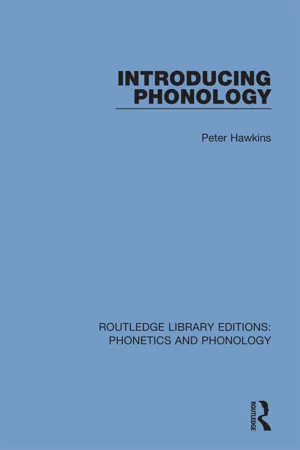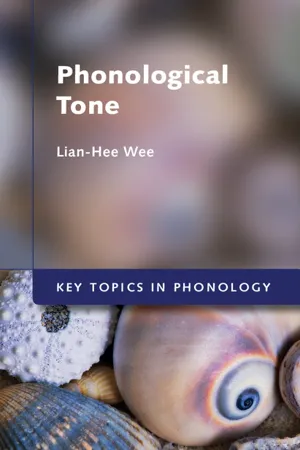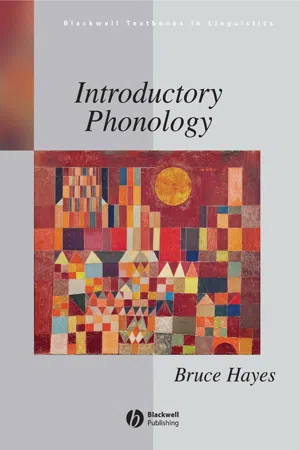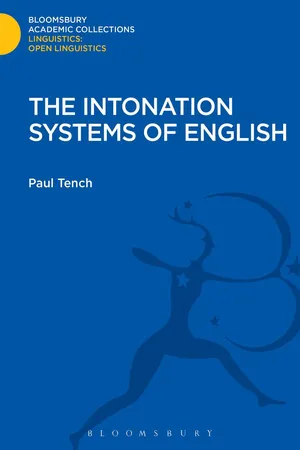Languages & Linguistics
Tone English Langugage
Tone in the English language refers to the attitude or emotion conveyed by the speaker or writer. It can be conveyed through the choice of words, phrasing, and overall style. Tone can range from formal and serious to informal and playful, and it plays a crucial role in shaping the overall meaning and impact of communication.
Written by Perlego with AI-assistance
Related key terms
1 of 5
11 Key excerpts on "Tone English Langugage"
- eBook - PDF
The First Glot International State-of-the-Article Book
The Latest in Linguistics
- Lisa Cheng, Rint Sybesma, Lisa Cheng, Rint Sybesma(Authors)
- 2014(Publication Date)
- De Gruyter Mouton(Publisher)
But English also has pitch contours. In addition, the contours are quite predictable (e.g. Goldsmith 1976; Liberman 1975; Pierrehumbert 1980). For this reason, English has been called a tone language, too. For example, Goldsmith suggests that in neutral intonation English words have the tone pattern (M)HL, where Μ is a mid tone and Η is linked to the stressed syllable. Some examples are shown in (3). (3) TONE IN ENGLISH Chi-ca-go M-H-L A-me-ri-ca M-H-L-L Bos-ton H-L Ca-na-da H-L-L Analyses like (2) and (3) can be extended to African languages (e.g., Goldsmith 1982; Kenstowicz 1987; Sietsema 1989; Kenstowicz & Kisseberth 1990), American Indian languages (e.g. Hinton 1991), and European tone or pitch-accent languages, such as Lithuanian (Halle & Vergnaud 1987) and Serbo-Croatian (Inkelas & Zee 1988). Such analyses raise serious Tone 253 questions for a typology of tone languages, as noted by Hyman (1978) and McCawley (1978). In particular, the distinction between tone and non-tone languages is no longer obvious. In addition, if English and Japanese are tone languages, one wonders what language is not. 1.2. Tone and intonation The pitch contour in English is often called intonation. Indeed, all non-tone languages have intonation (I will return to the question of whether tone languages can have intonation). Although both tone and intonation are characterized by pitch (for a discussion on the difference between pitch and the fundamental frequency, see Beckman 1986), one may still wonder whether they are different. For example, are tone and intonation produced by the same articulatory mechanism? Are tone and intonation perceptually the same? Should tone and intonation be represented with the same phonological features? Phonetically, there is no evidence that tone and intonation are made with different articulatory mechanisms (cf. Zemlin 1981). In addition, as far as listeners are concerned, tone (in Chinese) and intonation (in English) are interchangeable. - eBook - ePub
- Peter Hawkins(Author)
- 2018(Publication Date)
- Taylor & Francis(Publisher)
in addition the tones can be used to make lexical distinctions.2 Intonation is functional, i.e. it is used in a language for particular purposes and is never merely ‘decorative’ nor a way of avoiding speech becoming ‘monotonous’.3 Within any particular language, intonation is systematic; different speakers use the same patterns for the same purposes, though there may be (and usually are) dialect differences, just as segmental phonemes are systematic in the language as a whole, but each phoneme may be subject to different realizations according to the region, age, sex, etc. of the speaker.The functions of intonation in EnglishWe can group the functions of intonation under four general headings. Intonation serves:1 To structure the information content of a sentence so as to show which information is new or cannot be ‘taken for granted’, as against information which the listener is assumed to possess or to be able to acquire from the context (i.e. ‘given’ information). This is explained further below (pp. 199ff.)2 To determine the speech-function of a sentence, i.e. to indicate whether the sentence is intended as a statement, question, command, etc. (see below, p. 204).3 To convey connotational meanings of ‘attitude’ such as surprise, annoyance, enthusiasm, etc. This can include whatever meanings are intended, over and above the meanings conveyed by the lexical items and the grammatical structure. For example the sentence:thanks for helping me last nightcan be given more than one meaning. The difference between a ‘sincere’ intention and a ‘sarcastic’ one would be conveyed by the intonation. Note that in the written form, we are given only the lexis and the grammar. The written medium has very limited resources for marking intonation, and the meanings conveyed by it have to be shown, if at all, in other ways.4 To characterize a particular style or variety of the language (the stylistic - eBook - PDF
Best Words, Best Order
Essays on Poetry
- S. Dobyns(Author)
- 2016(Publication Date)
- Palgrave Macmillan(Publisher)
A word's connotative meaning includes its secondary meanings as well as its symbolic and cultural dimensions. Bread is the staff of life as well as a word for money. Intonation is the emotional 152 I Best Words, Best Order shading given by the word's stress and pronunciation. It also indicates whether the sentence is interrogative, declarative or exclamatory. In a piece of writing, such as a poem, intonation must be inferred from the context and/or from mechanical or formal devices such as typeface, punctuation marks, line breaks, meter, rhyme, the onomatopoeic values of sound and pitch and so on. It is through a piece of writing's intonation that we discover the intention of the writer. Tone controls how we read a word's denotative and connotative values. Tone is one of four general linguistic qualities making up a poem's form. The others are the relation between stressed and unstressed syllables; the aural qualities of language, that is varieties of rhyme, alliteration, vowel pitch, consonant quality and so on; and third, pacing, which is controlled variations in the forward momentum of the poem. Of these four qualities, tone is the most difficult to analyze because it is intangible. Like a person's emotional mood, it cannot be precisely measured. Yet if we do not correctly recognize the poem's tone, then we will be unable to discover its meaning and consequently its intention. Further, the tone of the poem and the tone of the speaker of the poem may be different, as in T. S. Eliot's ''The Love Song of). Alfred Prufrock" or Robert Browning's 'To His Last Duchess." Of these four qualities that make up a poem's form, we can say that tone is the way in which the manner of the telling is included in what is told; the manner of telling becomes part of the subject matter. - eBook - PDF
- Lian-Hee Wee(Author)
- 2019(Publication Date)
- Cambridge University Press(Publisher)
This extends to studies on the relation between musical tune and linguistic tone, including neurolo- gical studies (more in Section 7.3). Another issue that needs to be clarified is whether tone distinctions made in languages are musically related. For example, does a rising tone contour, say [35], correspond to some interval of a particular musical temperament? The short answer to this is no; tone distinc- tions in language are not reducible to musical intervals (at least there are no convincing reports of such a discovery). Researchers often use musical relations to approximate description of pitch differences in tonal studies, but that is not the same as saying that the tones used in linguistics accord with some defined musical temperament. On the one hand, one might be surprised at the lack of obvious correlation between linguistic tone and music, both of which are so fundamental and natural to human cognition. On the other hand, one might be less surprised if one takes a little time to learn about temperament in music. 250 cognitive aspects of tone DISCUSSION QUESTIONS If you enjoy composing songs, try writing an English song where the musical melody aligns with the intonation melody. For example, try to sing the following short speech from Hamlet (Act V, scene 1) so that the declarative, exclamation and interrogative intonations of each clause come across clearly. Alas, poor Yorick! I knew him, Horatio: a fellow of infinite jest, of most excellent fancy: he hath borne me on his back a thousand times; and now, how abhorred in my imagination it is! my gorge rims at it. Here hung those lips that I have kissed I know not how oft. - eBook - PDF
- Bruce Hayes, Bruce P. Hayes(Authors)
- 2011(Publication Date)
- Wiley-Blackwell(Publisher)
15 Tone and Intonation This chapter completes our survey of suprasegmental phenomena with tone and intonation. The chapter also covers the system of phrasal stress on which English intonation depends. 15.1 The Use of Pitch in Phonology Pitch can be considered as a purely physical phenomenon: the vocal cords can vibrate faster or slower, resulting acoustically in higher or lower fundamental frequency. Frequency is measured in hertz (Hz, cycles per second), and is easily measured and visualized with pitch-tracking equipment. 1 All (spoken) languages have pitch and vary it systematically. What varies greatly is how pitch is used in the phonological system. There are basically three types of languages. 15.1.1 Tone languages In a tone language, pitch is used to distinguish words, and must appear in the lexical entries of morphemes, just like phonemic segmental information. As with segmental phonemes, one can often find minimal pairs and other sets for tone. Figure 15.1 shows a minimal quadruplet from Igbo (Benue-Congo, Nigeria). The four words represent the four possibilities that can occur on disyllabic words in a system that has phonemic Low and High tones. In the figure, the accents (´ , ` ) are the IPA diacritics for high and low tone. Tones are also shown in the way they will be analyzed below, with H(igh) and L(ow) elements linked to them with lines. Above each form is a pitch track, which shows the changes in pitch over time. 1 The pitch tracks in this chapter were made with Wavesurfer, a free phonetics package available from www.speech.kth.se/wavesurfer/. To hear the examples, visit www.linguistics.ucla.edu/people/ hayes/IP/. 292 Tone and Intonation The pitch tracks show that the phonemic representation of tone is, as always in phonology, an abstraction: the tones are not “sung” in level pitch like musical notes, but have gliding allotones sensitive to the segmental and phrasal environment. Very often, tone languages lack stress; this is apparently true for Igbo. - eBook - ePub
- Bruce Hayes, Bruce P. Hayes(Authors)
- 2011(Publication Date)
- Wiley-Blackwell(Publisher)
Very often, tone languages lack stress; this is apparently true for Igbo. It is also possible for tone and stress to coexist: Bantu languages often have a complex tone system coexisting with a simple penultimate stress pattern.15.1.2 Intonation languages
In an intonation language, pitch does not distinguish words. Instead, there are phrasal-level pitch patterns which convey abstract meanings of their own, usually related to the information structure of the utterance. English and most other European languages are intonation languages. It is typical for an intonation language to have stress.The pitch tracks in figure 15.2 show the English word animal [ˈænəməl] as pronounced by the author using statement, then question intonation. The first and last syllables are shown linked to phonological tones, which will be explained in the discussion to follow.15.1.3 Pitch accent languages
Pitch accent languages are something of an intermediate case. Pitch is phonemic (distinguishes words), and so there are minimal or near-minimal pairs for pitch. Pitch accent languages differ from pure tone languages in that words can only have one prominent syllable. This syllable serves as the anchor point for a pitch change, and pitch in the remainder of the word is predictable, or determined intonationally. The limitation to one prominent syllable is reminiscent of the principle of culminativity in stress (§14.2.1.1).English intonationFigure 15.2Tokyo Japanese is a well-studied pitch accent language. Here, one particular syllable in a word can bear a high tone. The choice of which syllable (if any) bears high tone is unpredictable, and high tones must therefore appear in lexical entries. The pitch on all remaining syllables is predictable and can be derived by tonal insertion rules (see Further reading). In addition, many words of the Tokyo dialect have no underlying high tone; for these, all of the tones that appear on the surface are phonologically inserted. - D Westermann, Ida C. Ward(Authors)
- 2015(Publication Date)
- Routledge(Publisher)
Every verbal tense and mood also has usually its own tonal pattern which is distinctive, 2 i.e. a special arrangement of the tones of the elements forming the tenses—prefix, root, suffix, or auxiliary or verb particle. 409. It is difficult for the European to realize this, for he is not accustomed to thinking of intonation as part of the word itself. The student, however, should try to develop a tone memory just as he develops a grammatical memory, a memory for vocabulary and idiom, &c. He should learn the inherent tone of every word as he adds it to his vocabulary, just as in learning French and German the student learns the articles with the nouns in order to remember the genders. When learning the grammar of the language he should note the changes made in the inherent tones for different grammatical forms. 410. It is the work of the investigator to find out all the tone variations of a language and to set them out as clearly as possible for the learner. It is the learner’s business to try to use the tone patterns accurately; in doing this he will convey a right meaning, he will be using good tonal grammar and will speak the language with the correct musical accent. 411. The student needs preliminary training in the appreciation and reproduction of tones. A good musical ear is naturally a great asset in this work, hut it should not be thought that with an indifferent ear for music, it is impossible to learn to speak a tone language. Any ear can be improved by training, especially if the training is systematic and graduated in difficulty. The number and variety of tones to be learnt is small in most languages. (See § 415.) Where books have been written on the tones of a special language, or where dictionaries and grammars have indicated the tones in some manner, the work is somewhat simplified. The learner can study the tone usages of his new language and practise the examples which are given in the books: thus he is trained on the special tones he needs- Ulrike Gut(Author)
- 2014(Publication Date)
In tone languages, the pitch level or pitch movement on syllabi es determines the meaning of words. This means that nuclear tones, the tunes of utterances and pitch range are not used for linguistic purposes as they 132 Chapter4 are in English: nucleus placement does not indicate new and given information or focus; tones, tunes and pitch range are not used for the expression of attitudinal meanings or certain discoursal functions in the same way in tone languages. Consequently, native speakers of tone languages have to acquire an entirely new phonological system with a whole range of new phonological rules. When acquiring English, native speakers of an intonation language like Gennan or French have already learned the fundamental concepts of using intonation phrases, nucleus placement, pitch patterns and pitch range. Nevertheless, individual phonological rules of the meaning and usage of particular nuclear tones may differ between the language learner's first and second language. For example, in British English a low rising or falling-rising nucleus is often produced on statements or commands, which carries certain attitudinal implications such as leaving open the possibility of agreement or disagreement. Utterance (l 0 1) thus invites the conversational partners to voice their own opinion. (l 01) That's /hot In German, this usage of a low rise or fall-rise does not exist and falls are produced instead. German learners of English who produce a falling nucleus in these cases may thus inadvertently create the impression that they want to impose a belief on the conversation partner. Furthermore, learners of English with an intonation language as their native language may find it especially difficult to acquire the phonetic aspects of English intonation. For example, pitch range in British English is much wider than in German although it is used for the same linguistic purposes (Mennen 2007).- eBook - PDF
- Caroline Féry(Author)
- 2016(Publication Date)
- Cambridge University Press(Publisher)
135 135 6 Intonation and Meaning 6.1 INTRODUCTION The aim of this chapter is to examine the relationship between into- nation on the one hand and pragmatics, semantics and information structure on the other. The relation between meaning and intonation is at least twofold. First, the tonal contour of a sentence is shaped by information structure. The informational roles investigated in this chapter are focus, givenness and topic, as proposed by Krifka (2008), for example; see also Büring (2016a) and the collection of chapters in Féry & Ishihara (2016). These roles influence the prosodic phrasing and the tonal pattern of sentences by assigning special tones or tonal sequences to bearers of the information structural roles. Lexical stresses and boundaries can be more or less prominent depending on the status of the respective constituents: information structural roles can be conveyed by scaling of tones and scaling of reference lines. Moreover, in many languages, prosodic phrasing is changed as a consequence of information structure. Second, the choice of specific tones and the way they combine is essential in communication. In intonation languages, meanings and illocutionary roles influence the tonal patterns of sentences, and conversely, the choice of tones has an influence on the pragmatic interpretation of sentences. Intonation has a different role from the other grammatical modules, without being completely separated from other parts of grammar. Rather, the part played by an intona- tion contour interacts with other grammatical components to pro- duce specific nuances. The question of how intonation relates to meaning, which has been central in the discussion of intonation, especially in the models preceding the tone-sequence model, is given a simple answer in this chapter. As was demonstrated in Chapters 4 and 5, a prosodic domain is realized intonationally by tones with specific roles, such as pitch accent, lexical tones and boundary tones. - eBook - PDF
- Paul Tench(Author)
- 2015(Publication Date)
- Bloomsbury Academic(Publisher)
4 TONES THE TUNES OF INTONATION 1. Primary and secondary tones It is the tones of English intonation that most people are aware of. It should by now be clear that English intonation comprises three separate, though related, systems: tonality (intonation units), tonicity (the tonic syllables) and tone. But people are much more aware of the third system than they are of tonality or even tonicity Tone refers to pitch movements, and that observation which has frequently been commented on - 'that it is not what they said, but the way they said it' - relies primarily upon the pitch movements. We are aware of rises and falls of pitch and high levels, low levels, 'bouncing' movements, calling tones and so on, which all contribute to a wide range of different meanings. Tone has been defined hitherto as the contrastive pitch movement on the tonic syllable; so, for instance, in the standard example we took in Chapter 1, the tone of (1.10) A dog is a man's best friend is the falling tone on the tonic, friend. We now need to make a further distinction, because it is obvious that there are other pitch movements besides that which occurs on the tonic syllable. We make a distinction between primary and secondary tones. Primary tones are the basic contrastive pitch movements on the tonic, i.e. whether the pitch of the voice moves up (rises), or moves down (falls), or combines a movement of down and then up (fall-rises). Secondary tones are the finer distinctions of the primary tones, i.e. the degree to which the pitch of the voice rises, falls or combines a fall and a rise - whether there is, for example, a rise to a high pitch or a mid pitch, or a fall from a mid pitch or a high pitch, etc. Secondary tones also cover the pitch movements in the pre-tonic segment (the head and the pre-head). (Pitch movements in the tail are not considered separately from 73 - Martin Haspelmath, Ekkehard König, Wulf Oesterreicher, Wolfgang Raible, Martin Haspelmath, Ekkehard König, Wulf Oesterreicher, Wolfgang Raible(Authors)
- 2008(Publication Date)
- De Gruyter Mouton(Publisher)
In this view, intonation is essentially peripheral to language. It reflects a pre-linguistic com-municative code, and/or it depends on physi-cal properties of the speech production mech-anism. The important features of intonation are actually the same in all languages; any observable differences are merely convention-alized variations on the universal themes, and therefore any typological generalizations we may find will be different in kind f r o m those that can be drawn about phonology or syn-tax. In recent years the universalist view has lost some ground to what we might call the phonological approach, based on the work 98. Intonation 1381 of Bruce (1977), Pierrehumbert (1980), Beck-man (1986) and others. As we shall see in § 2.3., this approach treats intonation as part of phonology, and as such is compatible with the idea that normal typological generaliza-tions about intonation may be possible. Nev-ertheless, the universalist view still thrives, and one important task in writing about into-national universale and intonational typol-ogy is to do justice to both points of view. Section 2 of this article presents the undis-puted cross-language similarities of intona-tion first (§2.1.), together with a universalist interpretation (§ 2.2.) and a critical evalua-tion of that interpretation (§ 2.3.). Section 3 then summarizes three aspects of intonation — melody (§ 3.1.), sentence-stress (§ 3.2.), and phrasing (§3.3.) — that differ across lan-guages in a way that reflects possible typo-logical dimensions. Finally, §4. briefly dis-cusses several dimensions of what we might call the phonetic typology of intonation. 2. Intonational universals 2.1. Substantive universals The most basic use of intonation is to divide the stream of speech into chunks, which we will refer to here as intonational phrases or IPs.
Index pages curate the most relevant extracts from our library of academic textbooks. They’ve been created using an in-house natural language model (NLM), each adding context and meaning to key research topics.










